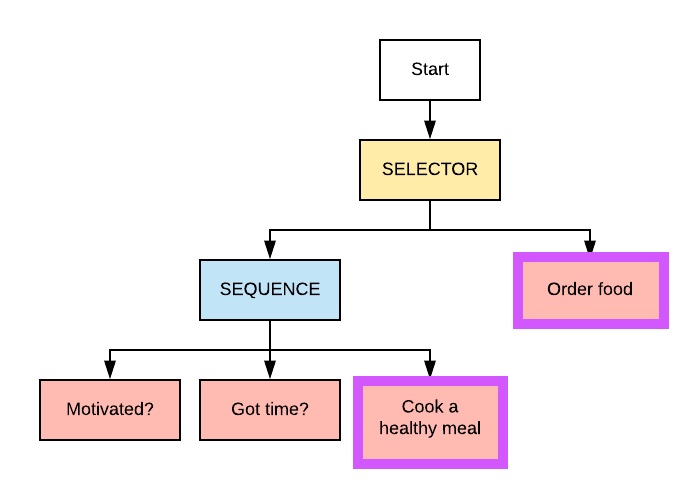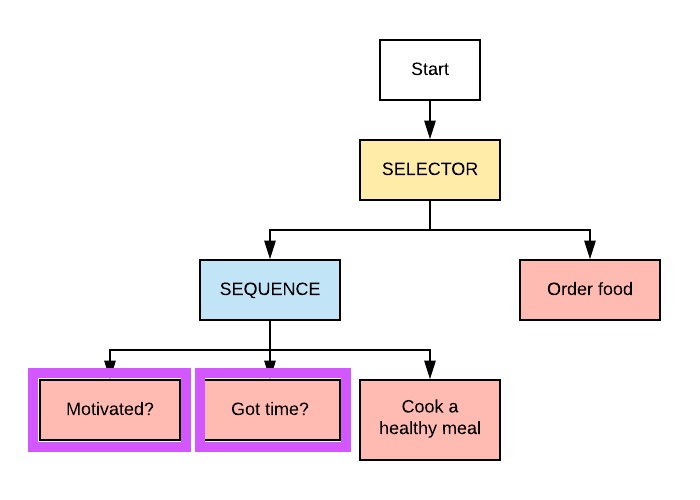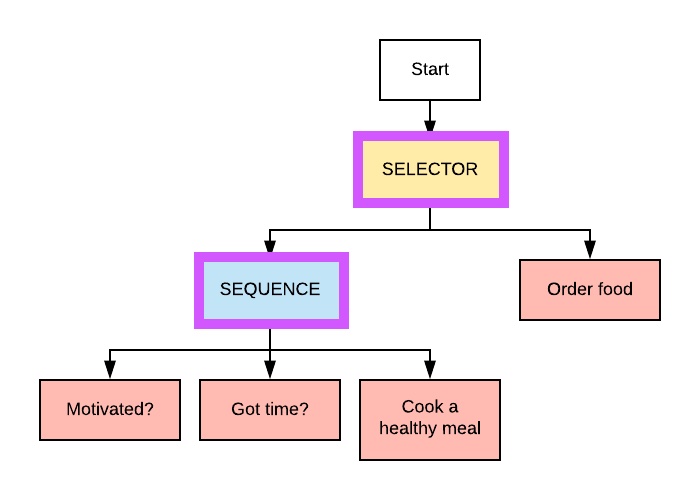Autonomous mobile robots (AMRs), defined as machines capable of navigating without human oversight, are automating tasks like transportation of patient samples, on-demand fetching of lab supplies, and automation of inventory logistics in healthcare and laboratory settings. With set-up behavior trees for AMR decision-making, this automation is made possible.
For these unpredictable environments, however, AMR robots require precision and smoothness of movement. Rigid, pre-programmed routines can cause bottlenecks when environmental conditions change – like if a misplaced wheelchair blocks a hallway, or lab equipment is rearranged.
Table of Contents
1. What is a Behavior Tree for AMR Robots
Behavior Trees are a visual, flowchart-like method for controlling the decision-making processes of Autonomous Mobile Robots (AMRs).
Unlike traditional programming methods, Behavior Trees are dynamic and adaptable. If an AMR encounters an unexpected obstacle, the tree allows it to recalculate its route in real-time rather than becoming stuck.
These customizable flowcharts guide an AMR’s decision-making. Instead of simply reacting to a single obstacle, a behavior tree enables a robot to re-assess its path in real-time, ensuring timely delivery of critical materials.
In healthcare and laboratory settings, Behavior Trees power AMRs that can
- transport delicate samples
- adjust grip strength to handle various objects
- navigate crowded or ever-changing environments.
This adaptability boosts efficiency while enhancing safety by minimizing the risk of collisions or damage in dynamic healthcare and lab environments.
2. Structure of Behavior Trees for AMR Decision-Making
Key Node Types in Behavior Trees for AMRs
Behavior Trees facilitate autonomous robot behavior through a combination of three key node types: Actions, Conditions, and Composites.
Action nodes specify the robot’s fundamental tasks. Condition nodes evaluate the environment or the robot’s internal state to influence decision-making. Composite nodes control the flow of execution within the tree, allowing for complex behavioral sequences.
Action Nodes
Action nodes are the building blocks of a Behavior Tree. They represent specific, concrete tasks that types of autonomous mobile robots must execute.

These actions are the foundation upon which more complex behaviors are built:
- Move to a designated location
- Pick up an object
- Place an object
- Open a door
- Sound an alert
Condition Nodes
Condition nodes act as checkpoints within the Behavior Tree. They evaluate the AMR robot’s surroundings or its internal state and then send signals to influence the tree’s execution flow.

Condition nodes may:
- Check if an obstacle is present
- Verify if a destination has been reached
- Determine if an object is currently being held
- Assess battery level
Composite Nodes
Composite nodes are like switches that control how the mobile robot moves through and executes the Behavior Tree.

There are several types of composites, each with a specific function, that create sophisticated behavioral sequences when combined together:
- Sequence: Executes child nodes one after another, like moving to a spot and then picking up an object, only progressing if all succeed
- Selector: Executes child nodes until one succeeds, allowing for fallback options. Basically, the robot tries different options until it finds one that works.
- Parallel: Executes multiple child nodes simultaneously, allowing the robot to multitask. This is essential for AMRs with multi-functional arms, like those used in labs for handling delicate samples and equipment concurrently, and AMRs in healthcare settings, that might need to navigate crowded hallways while simultaneously monitoring battery levels or sounding an alert if they encounter an unexpected obstacle.
3. Behavior Trees vs. Other Types of AMR Programming
Behavior Trees offer one significant advantage over traditional, linear robotics programming: they transform AMR development into a more modular, adaptable, and collaborative process − . Within these tree-structured frameworks, individual tasks and decisions become reusable ‘blocks’.
These blocks lead to faster development, greater resilience to real-world changes, and a shared language for both technical and non-technical stakeholders. Let’s dive into the key benefits:
Modularity & Reusability: The Advantage of Behavior Trees for AMR Robots
In order to teach an AMR a new skill, developers can leverage its previously-mastered abilities.
For example, if an AMR is capable of navigating to a lab station and picking up a sample, engineers can utilize these existing ‘navigation’ and ‘pick-up’ blocks to teach it to deliver that sample to a new location. Development can mainly focus on creating the new ‘delivery’ action and linking it within the tree.
- A ‘check battery level’ condition block can be reused in trees for various AMRs, regardless of their primary function.
- A sequence of “move to charging station > dock > charge” can be a self-contained branch, usable within different AMR flowcharts.
- A lab AMR’s tree for retrieving a specific supply type might be quickly adapted for a different supply by modifying only the object recognition parameters.
Adaptability: Embracing the Unexpected in Task Automation
A misplaced wheelchair in the way of its pre-planned route shouldn’t cripple an AMR’s entire task. Behavior Trees allow robots to react in real-time. If a planned route is blocked, a well-designed tree triggers a path recalculation or attempts an alternate route. This ensures timely deliveries and minimizes workflow disruptions.
- If a hospital room door is closed, an AMR’s tree could include a branch to wait a short time, then retry, and alert staff if the issue persists.
- A lab AMR could have ‘sample container full’ and ‘sample container empty’ conditions, triggering different routes for collection and delivery.
- Behavior trees can include ‘error handling’ branches, ensuring AMRs take safe, defined actions (like parking at a charging station) if a malfunction is detected.
Understandability: Beyond the Code
The visual nature of Behavior Trees makes them accessible to those outside of programming. This can transform collaboration within labs and hospitals. A nurse might suggest a more efficient route based on their knowledge of typical foot traffic patterns. Lab technicians could help troubleshoot an AMR’s manipulation issues by examining the logic flow of its tree.
- Using readily understood terms for nodes (instead of technical jargon) can empower non-programmers to suggest refinements for efficiency.
- Visual debugging tools allow teams to track the robot’s path through the tree, revealing why it made specific choices.
- In the future, user-friendly interfaces could allow frontline staff to make basic tree modifications, enabling immediate AMR adaptation to urgent tasks.
4. Creating Autonomous Robot Behavior
The true power of behavior trees lies in orchestrating complex and adaptable sequences of actions to achieve AMR behaviors that drive crucial goals in laboratory and healthcare.
Specific autonomous mobile robots examples each have specific functionalities, all of which are realized using simple building blocks:
Foundational Blocks of Autonomous Robot Behavior
The behavior tree elements we discussed earlier – including Action, Condition, and Composite nodes – act as modular building blocks for whole-sequence actions. By creatively combining and layering these nodes, engineers can develop increasingly sophisticated AMR behaviors.
Robotic Arm Function
Robotic arms give mobile robots the ability to interact with their environments with precision. Behavior Trees ensure their movements are safe, accurate, and optimized for delicate tasks often found in life sciences or healthcare research.
- In Hospitals: A hospital AMR tasked with restocking a lab might use a behavior tree to coordinate its arm movement and grip strength. It may adjust its grip based on whether it’s handling a fragile reagent vial or a sturdy instrument.
- In Laboratories: In a diagnostic lab, a Behavior Tree can fine-tune a robotic arm’s motions to transfer patient samples between testing stations with the utmost accuracy and sterility.
Object/Environment Sensing
For AMRs to make truly intelligent decisions, they must be aware of their environment. Behavior Trees integrate data from various sensors, making them a vital tool for AMRs in complex workspaces.
- In Patient Care: Within a patient room, an AMR assisting with meal delivery uses object recognition combined with Behavior Trees. This allows the AMR to identify if there is space on the table to set down the tray and can prompt it to alert staff if it can’t access the intended placement location..
- In Research: A Behavior Tree can enable a lab AMR to use sensors to identify and retrieve specific test tubes. It may then safely navigate to the appropriate testing station while carefully monitoring the contents.
5. Case Study: Behavior Trees in Quasi Mobile Robots
Behavior Trees don’t just exist in theory – they are a core technology driving the innovation of AMR automation today. Quasi Robotics, a leading autonomous mobile robots company, harnesses Behavior Trees to enhance the adaptability and performance of its robots, translating into real-world benefits that streamline operations and enhance safety.
Model C2: Behavior Trees for AMR Efficient Transport
Quasi Robotics’ Model C2 robotic cart is designed to streamline laboratory material transport. Its Behavior Trees are constantly at work. They enable the C2 to navigate dynamic lab spaces, even if boxes have been left in a hallway or a workstation has been reorganized. This adaptability translates into reliable delivery timeframes – critical when transporting sensitive samples or time-urgent supplies.
- Tree-Enabled Precision: C2’s Behavior Tree coordinates sensors and navigation. This allows it to avoid not only large obstacles, but also smaller items like a stray power cord or a misplaced reagent bottle, preventing collisions that could damage its cargo.
- Prioritizing Safety: If a person unexpectedly enters the C2’s planned path, the Behavior Tree instructs it to safely stop, re-assess its surroundings, and adjust its route while potentially alerting nearby staff to its presence.
Model R2: Behavior Trees for AMR Dexterous Manipulation
The Model R2 mobile manipulator features a high-precision robotic arm, allowing it to perform complex manipulation tasks vital for laboratory and healthcare workflows. Behavior Trees power the R2’s dexterity. They delicately adjust grip strength for handling everything from fragile vials to robust lab instruments. They also optimize the arm’s range of motion to work within tight spaces, ensuring its movements are safe and efficient.
- Careful Handling: The R2’s tree might integrate pressure sensors, allowing it to differentiate between delicate test tubes requiring a light grip and sturdier equipment. This minimizes the risk of breakage or sample contamination.
- Maximizing Lab Space: Behavior trees guide the R2’s arm through carefully calculated motions suitable for confined areas. This could include tasks like retrieving specific vials from a crowded storage rack or placing samples accurately within a centrifuge.
6. Behavior Trees for AMR Functions – Today & Tomorrow
Reinforcement Learning
Researchers are actively exploring areas like reinforcement learning to optimize mobile robot Behavior Trees to learn and improve their actions over time.
- This technology could lead to AMRs capable of making efficiency improvements, like a healthcare AMR autonomously suggesting optimized routes after numerous delivery runs.
Beyond optimized paths, reinforcement learning could empower AMRs to adapt their responses to dynamic factors within their environments, such as:
- Adjusting arm motions and grip strength in real-time based on the type and weight of an object being handled.
- Learning to anticipate potential obstacles (e.g., times of day with high foot traffic) and proactively planning alternate routes.
User-friendly interfaces
User-friendly interfaces hold the potential to revolutionize the human-robot relationship for enhanced adaptability and safety in healthcare and labs:
- Nurses could gain the ability to rapidly reprogram AMRs using a Behavior Tree interface to meet unforeseen needs in crisis situations.
- Lab technicians could modify how a robot handles hazardous materials via drag-and-drop adjustments to its tree, ensuring compliance and safety.
Empowering personnel
Consider the impact on regulated environments:
- Empowered Personnel: A lab technician could be empowered to adjust an AMR’s material cleaning procedure by modifying its Behavior Tree, ensuring alignment with evolving standards and protocols.
- Increased Frontline Staff Autonomy: Behavior tree modifications could allow nurses and technicians to solve workflow bottlenecks identified in the field, without relying solely on programming teams for AMR adjustments.
- Staff Skill Development: User-friendly interfaces designed for Behavior Tree adjustments could introduce frontline personnel to robotics concepts, fostering interest in further technical training.
7. Conclusion
As healthcare and laboratory environments evolve, adaptability within autonomous mobile robots (AMRs) becomes paramount. For a deeper understanding of what autonomous mobile robots are and how they work, Behavior Trees offer a key entry point. Behavior Trees offer a robust framework well-suited for these challenges. They empower AMRs with smooth movement, dynamic decision-making, and a capacity for ongoing refinement. For decision-makers seeking future-proof AMR solutions capable of optimizing efficiency and safety, Behavior Trees hold tremendous potential.
By leveraging Behavior Trees for AMRs, the Quasi Robotics autonomous robot company, delivers AMR robots that are not only reliable but also highly adaptable to evolving healthcare and laboratory needs. This adaptability underscores our focus on developing solutions that offer long-term value and flexibility for our clients as their requirements change.
Explore how Quasi Robotics leverages Behavior Trees to deliver next-generation AMRs ready to take on your most pressing workflow challenges.